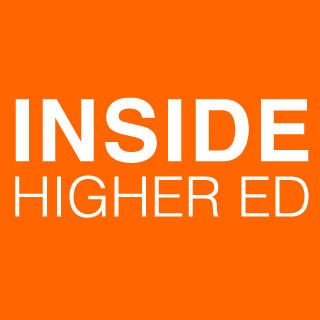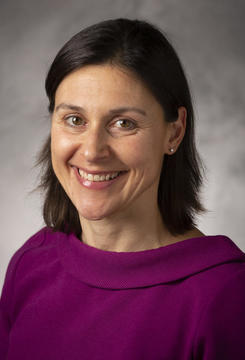
When CTL leaders move to institutional leadership roles, it “is a structural signal that teaching and learning are core priorities” for the university, says Poorvu Center Executive Director Jenny Frederick. On July 1, Frederick was appointed Yale’s new associate provost for academic initiatives.
The following is the full interview in Inside Higher Ed:
3 Questions for Yale’s New Associate Provost for Academic Initiatives, Jenny Frederick
When CTL leaders move to institutional leadership roles
by Joshua Kim
 On June 22, Yale University announced that Jenny Frederick had been appointed the new associate provost for academic initiatives. Jenny agreed to answer my questions about her new role.
On June 22, Yale University announced that Jenny Frederick had been appointed the new associate provost for academic initiatives. Jenny agreed to answer my questions about her new role.
Q: Jenny, first congratulations on the new role. Your promotion to associate provost for academic initiatives is a very big deal for those of us in the Center for Teaching and Learning community that dream of learning people ascending to institutional leadership roles. Can you share a bit about your goals as you begin this new role?
A: Thank you! In the abstract, this role isn’t about me. It is a structural signal that teaching and learning are core priorities for an institution. Broadly speaking, I intend to bring this perspective to my new areas of responsibility and ask questions about how decisions affect learning, how they promote teaching excellence, how they reflect what we know about how people learn.
I am brand-new in the role (effective July 1), so I have a lot to learn! As I’ve done so far, one of my near-term goals is to articulate principles I will rely on to provide leadership for complex areas. Valuing diversity and equity is high on that list, as well as aligning with institutional priorities. In all of my leadership roles, I emphasize communication and transparency about inevitable tradeoffs.
To expand on my commitment to diversity, equity and belonging, I believe that classrooms and research labs are places where these practices can make a daily difference. Teaching and learning centers are excellent resources to support equitable education. In my new role, I aim to level up my leadership in this area, in part by infusing these values into everything I do. In other areas, I will point out downstream effects of high-level decision making on inclusion and belonging for our faculty, our students and our staff colleagues. Most importantly, I will keep asking questions and listening with humility. Leadership doesn’t mean you have all the answers, but there is a greater responsibility to incorporate values into institutional directions and decision making.
The new role is a step further from programs and services for faculty and students, and some of the excellent colleagues who provide them. As I reflect on this change, I’m motivated to pay attention to its implications. How can I continue to keep an ear to the ground to feed awareness of what really matters to our faculty and our students? What opportunities will I have to exert influence in a way that helps them do their best? These are questions I will return to often.
Q: As I understand things, you will be retaining your role as executive director of the Poorvu Center for Teaching and Learning at Yale while also serving as associate provost for academic initiatives. How do the two roles complement one another, and what do you think might change about your Poorvu role?
A: Yes, I’ll be expanding my portfolio while continuing to lead the Poorvu Center. The associate provost role increases my connections to offices and systems that are critical for the university’s educational mission. Operationally, the Poorvu Center already has strong ties to the university registrar’s office and areas within information technology because of our integrated structure. All of these units have important contributions to academic processes, and each one plays a role in supporting teaching and learning.
Taken together, the areas for which I now provide leadership span a multitude of functions and processes. I will continue to rely on strategies that have served me well for leading the Poorvu Center, which is itself comprised of diverse teams with many types of expertise. Empowering others, elevating expertise, advocating for priorities and listening carefully while avoiding assumptions—all of these skills will be essential. Looking ahead, I anticipate that my multifaceted role will provide opportunities to chart strategic directions and make informed decisions that advance our educational mission.
As with any new role, there will be room to craft the position to meet emerging needs. Predictions may be premature, but I imagine increased attention on equitable and inclusive mentoring and consideration of institutional goals for online education. In particular, I will be thinking about Yale’s vision for coordinated infrastructure to support online and nondegree education, where that approach makes sense. At the same time, we need to recognize distributed excellence in these areas and amplify examples of how such programs are positively influencing residential education.
Taking on new responsibilities means that my attention will be divided as I learn new areas and get to know additional colleagues. Fortunately, the Poorvu Center is structured with functional teams that are both supportive and collaborative. People who work with me know that I am open to candid feedback, and I will continue to work hard to prioritize my time and provide support and leadership wherever I am asked. Maybe a year from now, we’ll check in and you can ask me to share the lessons I’ve learned in the new role.
Q: Your appointment to an associate provost role is one data point in a potential trend for CTL leaders to move into institutional leadership roles. Other examples are Mary Wright at Brown and Derek Bruff at Vanderbilt (among others). What advice would you give to others in the Center for Teaching and Learning world who are thinking about navigating their careers in order to create opportunities to move into universitywide leadership positions?
A: I’m glad you asked this question, because it highlights the vital role of CTLs in higher education institutions. Your question implies a telic orientation that I don’t hold, although I recognize this characteristic in others. My standard response always features advice to do your very best in the role you are in, and to stretch limits where you can go above and beyond to contribute value.
Recently, I was talking to a close colleague about administrative roles in higher education, and he likened it to effective teaching practices. Like good instructors, a good administrator is engaged and present—yet stays out of the way of those doing the work. I appreciate this viewpoint, since it’s not about a person taking credit, it’s about creating conditions for success and progress toward shared goals. That way of thinking about leadership resonates with me, and perhaps with your readers as well.
To quote another colleague I admire, I often think about Cassandra Volpe Horii’s characterization of educational developers in your Inside Higher Ed interview with her. Cassandra is now associate vice provost and director of Stanford’s CTL. She described skills where CTL leaders (and educational developers at all levels) tend to excel: collaboration, equity-oriented approaches, evidence-based practices and broad systemic thinking that promotes positive change within a complex institution. Cultivating these skills is highly relevant preparation for taking on more leadership.
Finally, I will quote myself! Alexandra Mihai, assistant professor of innovation in higher education at Maastricht University and Fulbright Schuman Scholar in residence at the Poorvu Center, recently interviewed me for her podcast. When she asked me to offer advice for other CTL leaders, my list included four items: 1) build a supportive network of peers; 2) align your work to institutional priorities, such as justice and equity; 3) know your boundaries, since good CTLs often get requests that go beyond their scope or capacity; and 4) take time to mentor others—not only will you learn from these conversations, but it’s a great way to pay it forward.
In simple terms, I find this career path rewarding because I am helping others. Ideally, advancing to a leadership role will allow me to be even more helpful in new ways.
